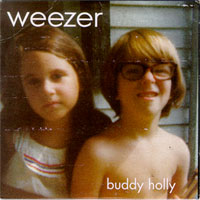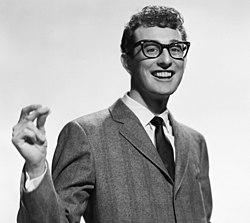Buddy Holly (song)
1994 single by Weezer From Wikipedia, the free encyclopedia
"Buddy Holly" is a song by the American rock band Weezer. The song was written by Rivers Cuomo and released by DGC Records as the second single from the band's debut album, Weezer (The Blue Album) (1994). The lyrics reference the song's namesake, 1950s rock-and-roll singer Buddy Holly, and actress Mary Tyler Moore. Released on September 7, 1994—which would have been Holly's 58th birthday—the song reached number two on the US Billboard Modern Rock Tracks chart and number 18 on the Billboard Hot 100 Airplay chart. Outside the US, the song peaked at number six in Canada, number 12 in the United Kingdom, number 13 in Iceland, and number 14 in Sweden. The song's music video, which features footage from Happy Days and was directed by Spike Jonze, earned considerable exposure when it was included as a bonus media file in Microsoft's initial successful release of the operating system Windows 95.
| "Buddy Holly" | ||||
|---|---|---|---|---|
 | ||||
| Single by Weezer | ||||
| from the album Weezer (The Blue Album) | ||||
| B-side | "Jamie" | |||
| Released | September 7, 1994 | |||
| Studio | Electric Lady (New York City) | |||
| Genre | ||||
| Length | 2:39 | |||
| Label | DGC | |||
| Songwriter(s) | Rivers Cuomo | |||
| Producer(s) | Ric Ocasek | |||
| Weezer singles chronology | ||||
| ||||
| Music video | ||||
| "Buddy Holly" on YouTube | ||||
| Audio sample | ||||
Rolling Stone ranked "Buddy Holly" number 484 in its list of "The 500 Greatest Songs of All Time" (2021), raising it 15 spots from number 499 (2010), and raised from around 19 years prior, being ranked number 497 (2004).[6][7] The digital version of the single for "Buddy Holly" was certified gold by the RIAA in 2006.[8] VH1 ranked it as the 59th greatest song of the 1990s in December 2007.[9]
Background and writing
Songwriter Rivers Cuomo wrote "Buddy Holly" after his friends made fun of his Asian girlfriend.[10] He originally planned to exclude it from the album; he felt it was "cheesy" and perhaps did not represent the sound he was pursuing for Weezer. Producer Ric Ocasek persuaded him to include it. In the book River's Edge, Ocasek is quoted saying: "I remember at one point he was hesitant to do 'Buddy Holly' and I was like, 'Rivers, we can talk about it. Do it anyway, and if you don't like it when it's done, we won't use it. But I think you should try. You did write it and it is a great song.'" Bassist Matt Sharp recalled: "Ric said we'd be stupid to leave it off the album. We'd come into the studio in the morning and find little pieces of paper with doodles on them: WE WANT BUDDY HOLLY."[11]
Critical reception
Summarize
Perspective
The song was released on what would have been its namesake's (left) 58th birthday. The song also references American actress Mary Tyler Moore (right).
Steve Baltin from Cash Box commented, "You’ve gotta love a song that makes reference to Mary Tyler Moore. Slightly poppier in its guitar sound than their first single, [...], this Ric Ocasek-produced song could help expand their already-growing fan base. Besides that, it mentions Mary, the woman who could turn the world on with her smile. Therefore, it has to be a hit."[12] John Robb from Melody Maker opined, "Weezer sound like The Proclaimers jamming with The Knack. This is pop-punk-by-numbers."[13] Pan-European magazine Music & Media wrote, "Made loud to play loud and sing along, it's the ideal power pop to cruise round this summer. That silly twin synth/guitar, betrays producer Ocasek, the one-time driver of New York's Cars."[14] A reviewer from Music Week gave the song four out of five, adding, "A short and sweet taster from the album which may not have the same quirky appeal of "Undone (The Sweater Song)", but has an attractive hook and a video to arouse interest."[15]
Johnny Cigarettes from NME commented, "A touching paean to nerdish social rejection from people who frankly deserve it. [...] But I am totally suckered by the pop majesty of a song that employs the long forgotten phrase Oo-ee-oo and drills an indelible mark on your taste buds such that you can never forget it's supernaturally banal chorus."[16] NME ranked it number five in their list of the Top 20 of 1995 in December 1995, writing, "Wahey! American rock ditches the pity-poor-me whingeing of grunge in favour of smiling faces, celestial Beach Boys-esque harmonies and The Tune That Ate Daytime Radio. Accompanied by the best video of the year."[17] Paul Evans from Rolling Stone noted "the self-deprecating humor" of lines like "I look like Buddy Holly/You're Mary Tyler Moore".[18]
Music video
Summarize
Perspective

According to Matt Sharp, Spike Jonze came up with three ideas for the accompanying music video for "Buddy Holly". Sharp stated that two of the ideas "weren't great". When Jonze pitched the idea that came to be the song's video, Sharp told Jonze "I don't think you'll be able to pull it off", but the band agreed to do it.[19] The video was filmed at Charlie Chaplin Studios in Hollywood over a single day and portrays Weezer performing at Arnold's Drive-In from the 1970s television show Happy Days, combining footage of the band with clips from the show. Happy Days cast member Al Molinaro made a cameo; he introduces the band by describing them as "Kenosha, Wisconsin's own Weezer". In fact, Molinaro himself was from Kenosha, while Weezer is from Los Angeles.[20]

In the climax, the video's stylist Casey Storm body doubled, and this allowed Fonzie to dance to the band's performance. The video also features brief cameos by some members of the band as dancers at Arnold's. Anson Williams, who played Potsie on Happy Days, objected to footage of him appearing in the video, but relented after receiving a letter from David Geffen, founder of Geffen Records.[11] According to drummer Pat Wilson, the video was achieved without computer graphics, only "clever" camerawork and editing. The video ended with Al complimenting the band on their performance, and asking if anyone had tried the fish, but they claimed it wasn't so good, and Al grudgingly agreed as he closed the restaurant for the night.[21] Sharp stated that the video was "pretty fucking wacky".[19]
The video was met with great popularity, and heavy rotation on MTV.[22] At the 1995 MTV Video Music Awards, it won Best Alternative Video, Breakthrough Video, Best Direction and Best Editing, and was nominated for Video of the Year.[23]
The "Buddy Holly" video was included on the Windows 95 installation CD-ROM, resulting in a skyrocket in popularity and earning Weezer a place in the history of MTV Music Video Awards.[24][25] Geffen did not tell Weezer they had negotiated with Microsoft to include the video; the band members, none of whom owned computers, were oblivious to the implications.[21] According to Wilson, "I was furious because at the time I was like, 'How are they allowed to do this without permission?' Turns out it was one of the greatest things that could have happened to us. Can you imagine that happening today? It's like, there's one video on YouTube, and it's your video."[21][26]
The video also appears in the music exhibit in the Museum of Modern Art. The music video was featured in Season 5, Episode 30 of MTV's Beavis and Butthead entitled "Here Comes the Bride's Butt" on June 9, 1995.
Impact and legacy
In 2004 and 2010, Rolling Stone ranked "Buddy Holly" numbers 497 and 499 in its list of "The 500 Greatest Songs of All Time". In 2021, the song was raised 15 spots in their updated list.[6][7] In December 2007, VH1 ranked it as the 59th greatest song of the 1990s.[9] In 2024, Forbes magazine ranked it number 45 in their list of "The 50 Best Songs of the 1990s", writing, "Weezer's 'Buddy Holly' isn't your average alt-rock anthem — it's a quirky, nostalgic trip back to the 1950s. With its catchy hooks and geeky charm, it's no wonder it captured the hearts of listeners everywhere. Lead singer Rivers Cuomo was a perfect fit for the song, which seemed to compare him to the late Holly in a fun way."[27]
Track listings
|
|
Personnel
- Rivers Cuomo – lead vocals, guitar, synthesizer
- Brian Bell – backing vocals
- Matt Sharp – bass guitar, backing vocals
- Patrick Wilson – drums
Charts
Weekly charts
|
Year-end charts
|
Certifications
References
External links
Wikiwand - on
Seamless Wikipedia browsing. On steroids.


